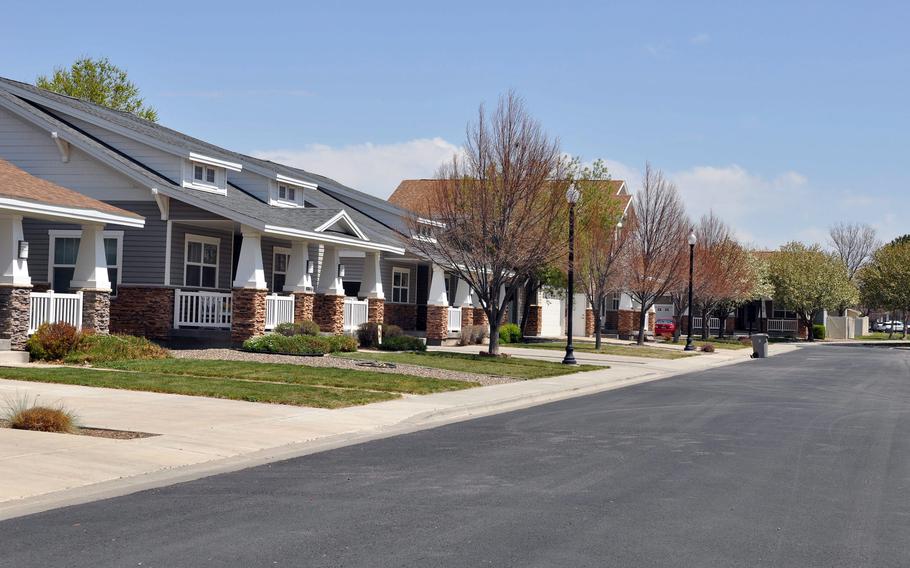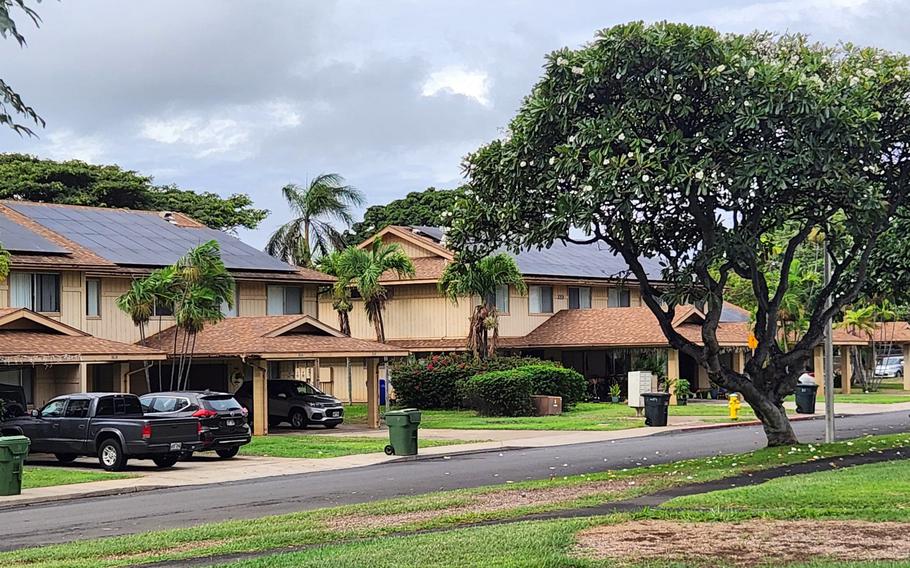
Housing at Mountain Home Air Force Base, Idaho. Service members and their families are increasingly feeling the pinch of a competitive housing market in some areas, according to a new Government Accountability Office report released Oct. 30, 2024. (Daniel Barnhorst/U.S. Air Force)
Service members shut out of high-priced housing markets have resorted to living in recreational vehicles, leaving families behind or working two jobs.
That’s according to a new federal report, which found major shortcomings in Pentagon housing allowances and other support and guidance governing affordable living quarters.
Recent boosts in the Basic Allowance for Housing and an expansion of the cost-of-living allowance from 5,000 to 17,000 service members have often proved insufficient in the search for a place to live, the Government Accountability Office found.
In a report issued Wednesday, the GAO said the Pentagon needs to have a better handle on housing availability and affordability challenges for its personnel.
And that requires a greater understanding of the property market in base communities, particularly those with housing shortages or high rental rates, the watchdog agency said.
From August 2022 to October 2024, a GAO team made in-person and virtual visits to seven stateside bases: Fort Bliss, Texas; Mountain Home Air Force Base, Idaho; Naval Air Station Key West, Fla.; and Camp Lejeune, N.C.; as well as U.S. Army Garrison Hawaii, Marine Corps Base Hawaii and Joint Base Pearl Harbor-Hickam, which is also in Hawaii.
The BAH is based on location, rank and family size. It is designed to allow service members to live off base comparably to their civilian counterparts by covering a portion of the monthly costs of rent and utilities.
But some respondents said they paid up to a thousand dollars out of pocket per month because of a shortage of options at costs close to or under their housing allowance, the report said.
Service members in Key West, for example, where long-term rentals are scarce and typically require significant upfront move-in cost, described having to withdraw retirement savings, incur heavy credit card debt or find additional employment to afford rent, utilities and other items such as gas and groceries, the GAO found.
At two unidentified installations, discussion group participants told the GAO team that they themselves lived in RVs or knew others who did because a more suitable residence was out of reach.
Others said they had to live in homes without air conditioning in hot, humid climates or in unsafe neighborhoods, the GAO said. Service members also described having to live with several roommates to afford housing, according to the report.
Some said it was financially more viable to leave their families behind in other states and rent a single room in a shared home or live alone in a studio apartment.
At Mountain Home, many service members seek housing about 50 miles away in Boise, which they said has more housing options.
But that commute can be dangerous or degrade the base mission in winter, said one Air Force official, since the interstate between the two communities shuts down several times a year due to traffic accidents and bad weather.
DOD’s guidance on housing management requires that the military services analyze housing requirements and market conditions for their respective installations to determine whether there is enough housing in the area.
But the services have not consistently completed these assessments on time, and DOD was late in fulfilling a statutory requirement to submit to Congress the services’ plans for completing the reports in 2023 and 2024, the GAO said in its findings.
In addition, DOD doesn’t use its housing assessments and other information to identify and regularly update a comprehensive list of military housing areas with critical availability and affordability challenges, according to the report.
Furthermore, savings from living near an installation with a commissary and base exchange may be less than expected, the GAO said.
The Pentagon’s formula for calculating basic housing allowance and COLA may need to be revised based on discussions with Defense Department officials and others, the report said.
Among its six recommendations, the GAO said the Pentagon should develop a comprehensive list of critical housing areas that includes information such as vacation rentals, which can affect the local housing market.
The department also needs to obtain feedback on the effects on service members living in these areas and develop feasible solutions, such as increasing the housing supply or alternative compensation like assignment or special duty pay.
The Pentagon agreed with the GAO recommendations, according to the report.

Duplexes line a neighborhood street at Joint Base Pearl Harbor-Hickam, Hawaii. The Defense Department needs to better understand the housing market in base communities, particularly those with housing shortages or high rental rates, the Government Accountability Office said in a report Oct. 30, 2024. (Wyatt Olson/Stars and Stripes)